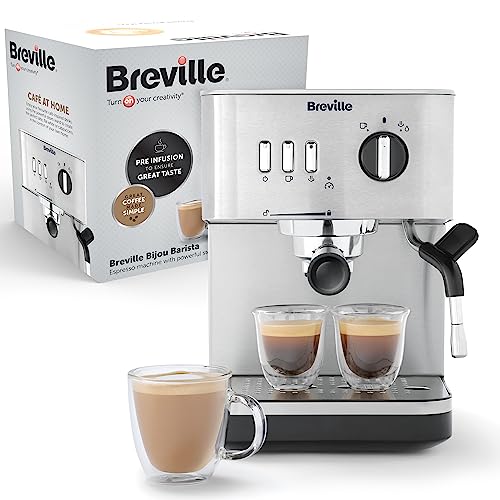How to Maintain Espresso Machines
Businesses such as car dealerships doctor's offices and hair salons are able to benefit from providing espresso drinks. Providing these gourmet drinks can increase the patience of customers while waiting for service and improve the ambience of your establishment.
A Good Housekeeping 2022 Espresso Machine winner, this machine utilizes smart dosing technology to weigh and dispense the perfect amount of ground coffee for each shot. It also comes with a milk dispenser that was a success in our tests.
The Basics
Espresso machines are a fantastic accessory for any home or office. They can be used to make many different drinks like cappuccinos and lattes. They work by forcing hot coffee through the ground under high pressure. This results in a concentrated shot that is bursting with flavor. It is a rich source of caffeine, which is an effective stimulant.
These types of machines are available in a range of sizes, from small models that are ideal for homes to larger models that are designed for commercial use. They are available in both manual and semi-automatic designs. Semi-automatic models have a built in pump that controls the flow and pressure of water. Manual machines require you to manage this manually. Certain semi-automatic models feature grinders while others do not. The kind of machine you choose will be based on your personal preferences and budget.
The manual espresso machine operates by turning a handle which pushes water through grounds of the form of a filter basket. This kind of machine, also known as a macchinetta or caffettiera, is the most popular model of espresso maker. It features a bottom chamber that holds the water, and a top chamber that has the filter made of metal. When it's heated, the steam from the water is forced through the grounds before it is pumped into the top chamber, where the brewed espresso is ready to serve.
Varieties

There are various types of espresso machines based on your needs. They include semi-automatic, manual and fully automated coffee machines. Each has a unique method of making an espresso shot as well as a variety of other drinks like cappuccinos and lattes.
The first machines were not fully automated, requiring the user to operate the lever manually which created the pressure needed to brew a shot espresso. While these machines are still in use however, they aren't as widespread because they require much effort and are often exhausting to operate. Modern espresso machines use various mechanisms to generate pressure, including screw, push and see-saw designs. This lets the user control pre-infusion and water volume more precisely than the lever machine.
Pump-driven espresso machines are similar to stovetop mokapots, however, they use an electric pump to press the coffee grounds instead of steam. They are equipped with a boiler, which brings the water to a boil then a pump forces it through a group head into the coffee. They are the most popular types of espresso machines and are generally less expensive than other types.
Semi-automatic espresso machines combine the best features of pumps-driven and manual espresso machines. They let the user grind and tamp the beans, but a motor regulates the pressure to ensure uniformity during extraction. They also have a separate compartment which can heat and froth milk, and some are equipped with an integrated grinder.
Functions
Commercial espresso machines can make numerous espressos and coffees at the push of the button. They use pre-packaged pods that have been precisely dosed and packaged to produce one cup of espresso or coffee. These machines are streamlined and are free of the requirement for a grinder, dosing and tamping, which makes them an ideal choice for busy offices. Since espresso coffee machines don't have steam functions, a separate milk frother is required to make cappuccinos and lattes.
Many cafes in Europe used steam machines to increase production and speed up brewing. The early machines were heated on an open flame, which resulted in unbalanced pressure and temperature. The inventor Angelo Moriondo of Turin, Italy is credited with establishing the first machine that was capable of brewing espresso without steam.
The most popular type of machine today is the pump-driven espresso machine. These machines use a portafilter to store the ground espresso beans. When the valve switches to the espresso position it extracts the espresso from the water under 15 atmospheres of pressure in a heating vessel. After the brew process is complete, the portafilter is taken out and emptied in order to be cleaned.
Automated espresso machines are semi-automatic systems, by controlling the extraction times based on internal or volumetric timers. They also remove the barista's capacity to tamp and grind coffee, which impacts the quality of the final product.
Maintenance
Espresso machines aren't the most elegant piece of equipment you can find in the coffee shop, but they are extremely important. The way you maintain your espresso machine can affect the taste and quality of your beverages.
Clean espresso machines ensure that the flavor of your coffee isn't compromised and ensure that your customer's experience is pleasant. A regular schedule of cleanings will prolong the life of your espresso machine.
Use a damp cloth to clean the portafilters and baskets each shift to get rid of any oils or residues. During this time, backflush portafilter gasket (the seal between the portafilter's seal and the group head) by inserting a nylon brush inside the gasket and then moving it around to dislodge any buildup. Rinse the gasket, and then repeat the process until the water is clear.
Mix espresso machine cleaner with water in a container as per the instructions of the manufacturer each week, or as required. Then soak the portafilters, grates, and baskets for a night in the cleaning solution. If your espresso maker comes with a steam wand or screen, take them out of the entire group with the screwdriver. Separately soak them in the cleaning liquid.
